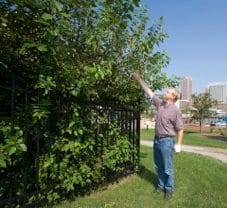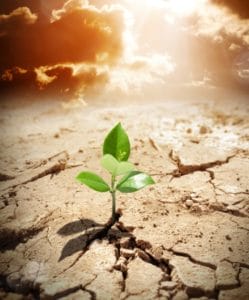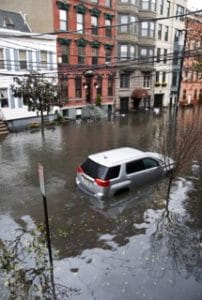Climate change is driving our planet’s surge in hurricanes, wildfires, deluges and droughts. It is a new environment of extremes, where mold, pollen and pollution proliferate. And who feels the direct health effects? As Allergic Living revealed in this article from 2015 – those with allergies and asthma.
Caroline Moassessi is used to looking out the windows of her home in Reno, Nevada and seeing the mountains. But in late August 2013, as the third-largest wildfire in California’s history burned tens of thousands of acres in Yosemite National Park, all she could see was the color grey. Smoke, soot and ashes had blown in 150 miles, prompting air quality warnings, canceling outdoor sports and forcing kids to stay inside at their schools. Even people without a history of asthma were struggling to breathe; some paid visits to doctors for inhaler medication.
Moassessi knows of children with respiratory conditions whose physicians sent them out of town while the smoke was bad. “It was scary,” recalls Moassessi, whose own children, then aged 10 and 15, both have asthma. “The first thing I would think when I woke up was, ‘How am I going to keep my children out of the hospital today?”’
In October 2012, at the opposite end of the country, the destructive hurricane that came to be known as Superstorm Sandy barreled up the east coast, making landfall in New Jersey. When the storm surge hit New York City, it flooded streets and the subway system, and brought blackouts and fires.
Ultimately Sandy took the lives of 72 Americans, and devastated seashore communities. Those who experienced this hurricane know that it had a widespread effect on health, too. Mold grew rampant – in people’s homes, but also in the grass and on trees.
Extreme weather events, from coastal flooding, intense heat, record amounts of rainfall in some areas and historic droughts in others, are becoming increasingly common as the Earth’s average temperature rises. The World Meteorological Organization has linked some of 2013’s most extreme weather events – Typhoon Haiyan in the Philippines, flooding in central Europe and record high temperatures in Australia, Asia and Africa – to human-induced climate change.
“There’s been a general disruption of nature,” says Kim Knowlton, a senior scientist in the Natural Resources Defense Council’s health and environment program. The U.S. Global Change Research Program (GCRP) released a comprehensive report on the impacts of climate change. It bluntly states: “Over the last 50 years, much of the United States has seen an increase in prolonged periods of excessively high temperatures, more heavy downpours, and in some regions, more severe droughts.”
Weather Events Affecting Allergies
It’s not that hurricanes are new, or that the Earth has never seen forest fires or intense heat. But as the ocean and air temperatures are rising, the conditions that these events are taking place in are changing. Brenda Ekwurzel, a senior climate scientist with the Union of Concerned Scientists, likens it to playing on a grass tennis court rather than clay. “The players are the same, but when they’re hitting the balls on the grass court, they are going much faster.”
When it comes to environmental allergies and asthma – whether the offender is pollen, mold or air pollution – sufferers are at the mercy of what is in the air when they walk out their front doors. Climate change, and the extreme weather events that come with it, are altering that air. Simply put, the game is changing for people with allergies and asthma.
The effects are plentiful and far-reaching. Jody Shields, a mother of two boys in High River, Alberta, isn’t typically too bothered by allergy symptoms in the spring. But in the spring of 2014, 11 months after heavy rain swamped her small town, overflowing the river and forcing all 13,000 residents out of their homes, things have been different. Her yard, normally grass, remains covered in mud. In fact, the entire town is muddy, and as it begins to dry up, dust is everywhere. Shields’ allergies kicked into high gear and her asthma flared.
To protect against future catastrophic floods, the city is building a berm close to her home. But with gravel trucks driving by every 15 minutes, “it was just so dirty,” she says, and that’s further aggravating her asthma.
Air quality right around the globe is showing the impact of changing weather patterns. In Paris, the city where springtime is for lovers, the government was forced to restrict cars from entering the city in March 2014 after air pollution reached unsafe levels for five days in a row. Unseasonably warm temperatures and lack of rain trapped smog particles above the city.
Knowlton says with a changing climate and increasing unusual weather, what we’re experiencing is just the beginning. “People are going to have to contend with new sets of conditions and perhaps symptoms more than they’ve ever had to before,” she says. The question is, are we ready?
The Floodgates are Open
When the rains arrived in Jody Shields’ town, it wasn’t just that 13 inches of water fell. It was that so much rain came down in just 48 hours. The sudden deluge in High River and other parts of the province caused rivers to flood, forcing more than 100,000 residents in all to flee as water engulfed their homes. Residents of Mobile, Alabama, and Pensacola, Florida will relate. A southeastern storm system in April 2014 unleashed biblical rainfall on those cities, more than 11 inches in 24 hours – with widespread flooding.
“We’re seeing a pattern with how precipitation is delivered,” explains Ekwurzel. “We see a decrease in the lighter rains and an increase in the most intense precipitation.” According to the GCRP report, the U.S. northeast, Midwest and upper Great Plains have seen the greatest change in rainstorms – with heavy rains now dumping more than 30 percent more precipitation than in the past.
To grasp the increase in big rain or snowstorms and its link to rising temperatures, think back to grade school lessons about the water cycle. Water travels in the air, and warmer air can hold more water vapor. Then, when a storm system comes together, whether an inland storm or a coastal one, like Hurricane Sandy, “there’s more water available to organize and it can fall as rain or snow,” says Ekwurzel. With climate change, there is also greater risk of coastal flooding, as sea levels rise with all the ice melting on land.
These big dumps of rain or snow spell trouble for people with allergies. “When the precipitation causes flooding in our homes, and our schools, we have to be mindful of moisture and mold damage,” says Knowlton, whose research focuses on how climate change is affecting health, including asthma and allergies. “For a lot of people, both moisture itself and mold can be an asthma trigger.”
10 Times the Ragweed
On a hot, smoggy day, walking outside can be enough to cause an asthmatic’s chest to tighten. Unfortunately for the 26 million Americans (and three million Canadians) who have asthma, these types of symptom-inducing days are on the rise. Burning fossil fuels – coal, petroleum and natural gas – emit the heat-trapping gas carbon dioxide, which is primarily blamed for climate change. But pollution from the same fuels, whether from vehicles, factories or power plants, when combined with sunlight and heat, becomes ground-level ozone, which is the main component of smog.
So as the Earth warms, burning fossil fuels – the very thing causing temperatures to rise – becomes an even larger health hazard. To Knowlton, this is one of the biggest risks from climate change for people with asthma and allergies.
For a glimpse into what a hotter future might hold for people with hay fever, look no further than Baltimore. There, Lewis Ziska, a researcher with the U.S. Department of Agriculture who is an expert in how climate change is affecting weed growth, designed an ingenious experiment. Baltimore’s downtown, like many large cities, is hotter and has more carbon dioxide than the suburbs and rural areas, making it a perfect “surrogate” for a future where we have not limited CO2 emissions. He grew ragweed plants in the three different areas and found the ones grown downtown were producing about 10 times more ragweed pollen than the ones in the rural areas. (“Remember, carbon dioxide is what plants take in, in order to live,” says Ekwurzel.)
Ziska has more bad news. He’s done other research that proves the ragweed season is longer now than it was in the past, and more so in the more northern latitudes. In fact, the ragweed season in northern states has grown by two weeks since the 1990s, stretching to almost four weeks longer in southern Canada.
Climate change research is showing that temperatures are rising more as you go toward the North Pole. The average temperature in Alaska has risen 3 degrees Fahrenheit since 1949, twice that of the rest of the United States. As the northern regions of our continent heat up, plants are thriving there that never would have survived before, exposing even more people to pollen from trees, grasses and weeds. The same goes for insects: yellow jacket wasps are stinging Alaskans, and triggering allergic reactions, in numbers never seen before.
 A neighborhood is in flames near the foothills of Colorado Springs during the 2012 Waldo Canyon fire.
A neighborhood is in flames near the foothills of Colorado Springs during the 2012 Waldo Canyon fire. Weather and Wildfire Watch
Morgan Smith was at home alone in June 2012 when the Waldo Canyon forest fire suddenly picked up speed and intensity and began torching homes in a nearby neighborhood of Colorado Springs. “I have to say, that was scary,” recalls Smith, who has asthma and food allergies. Fortunately, the Smiths had already packed up many of their belongings. “All of our important medical documents and extra prescription medications were packed up. We were ready to go,” he says.
When his parents arrived home they put everything into cars, Morgan with a bandana covering his mouth and nose because the street was filled with smoke, and drove to his grandmother’s house. There, he spent the next four days lying next to a fan and taking his asthma medication religiously.
Large and intense wildfires are happening more frequently. On average, between 1984 and 2011, there were seven more large wildfires each year than the year before, according to research from the University of Utah. As temperatures rise, more water evaporates in the hottest regions, leaving them even drier than before. Before the Waldo Canyon fire, Colorado had been experiencing an extended period of little rain and by late June, when the fire started, temperatures were above 100 degrees Fahrenheit, which is unseasonably hot for that time of year.
Ekwurzel explains that in desert regions, “droughts are hotter than they were in the past. They are more dangerous for a wildfire risk because it’s a tinderbox out there.”
Wildfires, whether burning in a nearby neighborhood or, as in the case of Moassessi, 150 miles away, can severely impact air quality and people’s ability to breathe. “In the wildfire smoke, there’s the precursor chemical that makes up ground-level ozone, that contributes to smog,” says Knowlton. “Fires produce tremendous amounts of fine particles, which are really damaging to health because they get into a person’s lungs.”
Wave of Cold Weather Change
In colder winters, many people in the United States and Canada scratch their heads, wondering “what’s this about global warming?” Many states in recent years have experienced unusually large amounts of snow. It all relates back to changing weather patterns, says Ekwurzel, and in this case, a meandering northern jet stream.
“Climate change is changing the background conditions and that means the cascading consequences can be very complicated,” she says.
Unusual weather can yield unusual symptoms: a late start to spring can prompt a greater prevalence of pollen allergy symptoms; related to trees budding all at once.
 Plant expert Lewis Ziska examines weed growth. He has found that ragweed thrives in hot, smoggy conditions.
Plant expert Lewis Ziska examines weed growth. He has found that ragweed thrives in hot, smoggy conditions. Allergy Outlook
With more moisture, mold, pollen and air pollution, Mike Tringale, (former) senior spokesperson for the Asthma and Allergy Foundation of America, says the 40 million Americans with environmental allergies are facing an uphill climb. “Our quality of life is increasingly even more at risk. We’re not seeing a reduction in things that are triggering our symptoms, we’re seeing an increase.”
What this means, says Tringale, is that some people are going to have to change the way the treat their disease. Rather than self-medicating with drugs available over-the-counter, Tringale says a more nuanced approach with a doctor’s assistance becomes necessary. It will be increasingly important for both people with asthma to heed air quality warnings and people with allergies to plan their outdoor time according to pollen counts. Good asthma management, with the right medications, will become even more crucial.
“People are going to have to work with their clinicians more closely as weather patterns are disrupted by climate change,” agrees Knowlton. She points to modern technology, such as smart phone apps that show air quality and pollen counts, as the tools to help us “thrive in the changing face of nature.”
Morgan Smith says that his family likes to plan ahead, which helped them when they were forced to evacuate. But in the Smiths’ case, they were also put on pre-evacuation notice a few days prior to having to leave their home, which gave them some time to prepare.
In the case of extreme weather, we won’t always get notice. Jody Shields had just minutes to get out of her house when water was threatening to engulf her home. Did she remember to bring her and her son’s asthma inhalers? “No. I grabbed my phone, my iPad and the charger, and like, five diapers.”
If climate change is like a game of tennis, for years the game has been played away from home. We’ve seen it in photographs of polar bears and vanishing Arctic ice. But now it’s on home turf. It’s affecting our health, and the health of our children. To Knowlton, it’s a call for action.
“Switching to healthier, renewable energy sources is the way that we’re going to limit the worst effects of climate change, which is absolutely urgent at this point. We really need to trim our carbon pollution now.” As it stands, temperatures in the United States are projected to increase anywhere from 5 degrees Fahrenheit to 10 degrees Fahrenheit by the end of the century. Can we afford to wait?
Related Reading:
Thunderstorm Asthma and pollen allergies: strange and dangerous combination
All about ragweed allergy: from symptoms and avoidance and treatment








